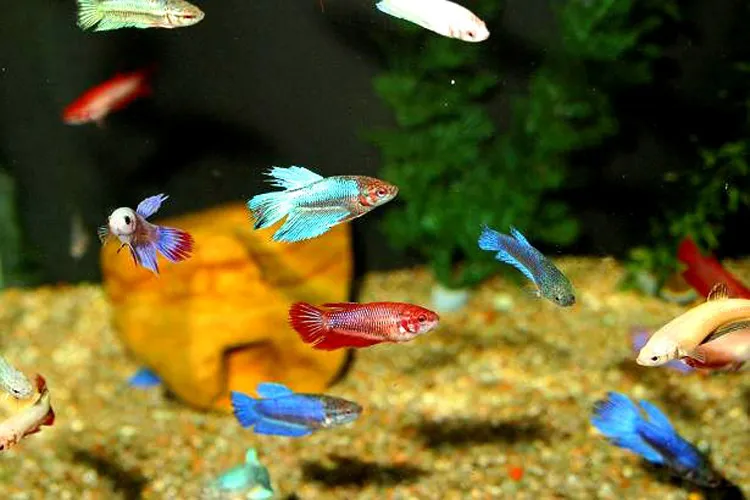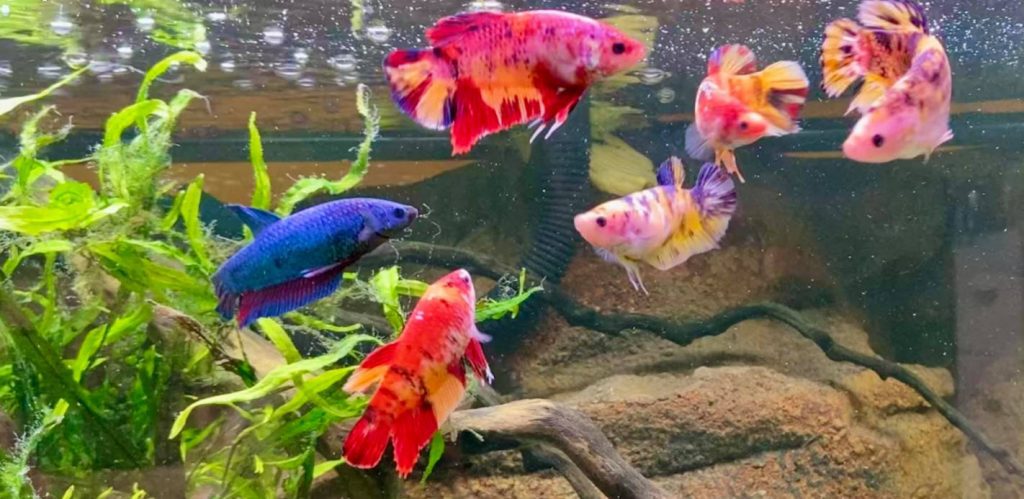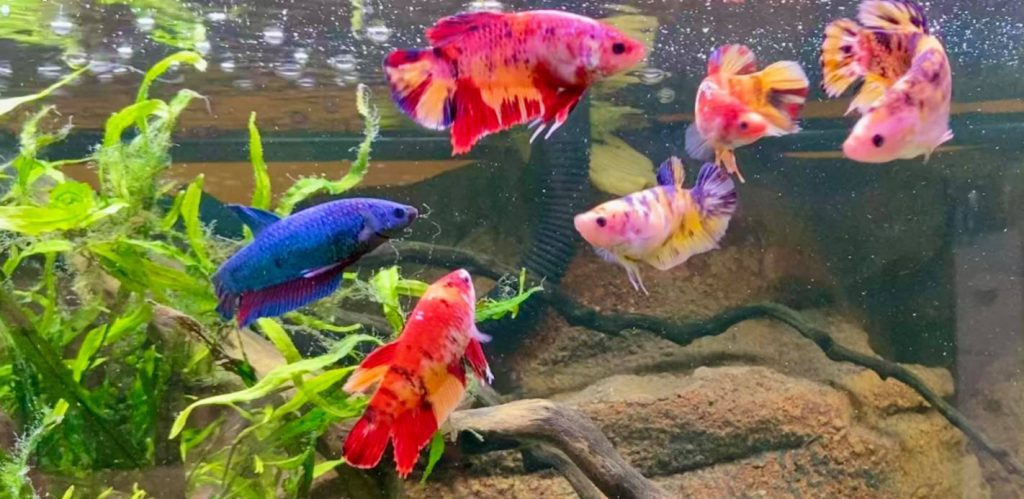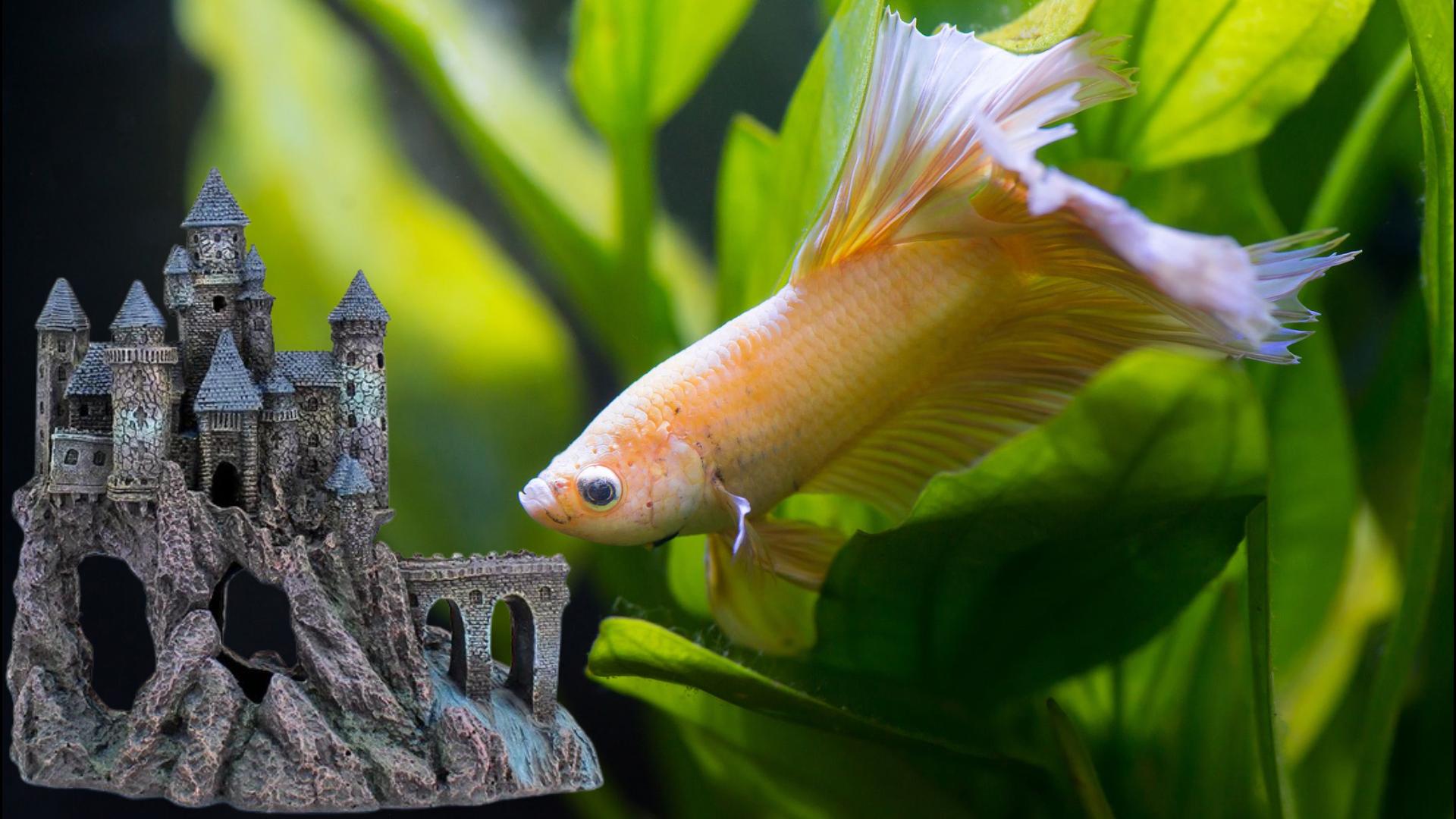Are you thinking about starting a betta sorority tank? In this blog, we’ll explore some important considerations for setting up your betta sorority and provide you with valuable tips on how to properly care. We have answered several interesting questions about sorority tanks and how to keep them thriving. So keep watching till the end without skipping. Let’s get started.
What Is A Betta Sorority?
In general, “sorority” refers to a group of animals with similar interests and ways of surviving. A betta sorority refers explicitly to a group of female betta fish living together. It has become popular among fish lovers as it is more fun to keep many colorful female betta fish in a single tank. That being said, female betta sororities can be an exciting tank when you do it right. There are many fish keepers who have created beautiful sorority tanks with multiple female betta fish. The key to a successful sorority tank is picking the right betta fish for your sorority tank, providing a proper aquarium setup, and quickly addressing any tank problems.
#1. Can I have a betta sorority tank?
Yes, the Betta sorority is a considerable option for everyone if you follow certain rules. It’s important to ensure that each fish has plenty of space to swim and live comfortably. Overcrowding can lead to stress and problems, even though female betta generally have fewer fighting issues. It’s important to keep an open mind when creating a Betta sorority. There is a possibility that some female Betta fish may cause problems. If the betta becomes aggressive, be prepared to make changes and potentially separate the fish or move away from the sorority setup.
#2. How Many Betta Can I Have in a Sorority?

There are many online debates and opinions about a Betta sorority. My recommendation for a Betta Sorority tank is to have at least 3 female betta fish and a maximum of 10 betta fish. The tank size should be at least 10 gallons; I don’t suggest starting with anything smaller than that. In general, one betta fish needs at least 2 gallons of water in a sorority tank. This means you can have up to 5 female betta fish in a 10-gallon tank for a healthy and stress-free environment. If you add more fish to the sorority, you can increase the tank size accordingly. These are just my primary suggestions based on my experience with sorority tanks. Please share your thoughts in the comments section.
#3. Why is it exciting to have a sorority tank?
Betta fish are territorial, making it challenging to keep them as a group. Many Betta keepers dream of having a large tank with multiple peaceful male Betta fish, like a community tank. Unfortunately, this setup doesn’t work well with male Betta fish. Female Betta fish especially recent breed varieties have become more colorful and vibrant, making it exciting to keep them together. It has been observed that female Bettas tend to be more peaceful towards other females with different colors. This opens up the opportunity to create a sorority tank with a variety of colors and patterns of female fish together.
#4. Can a Male Betta Live in a Sorority?
While it is possible to have one male in a sorority tank, I still do not recommend it. In my opinion, it will only bring stress and tension to the tank without any real benefits. Personally, I suggest avoiding male betta fish in a sorority tank mainly because of their aggressive nature. Another issue that arises when males are in a sorority tank is their breeding behavior. Introducing a male Betta can trigger breeding instincts in both male and female fish. This can destabilize the sorority tank and may lead to aggression, stress, or unsuccessful breeding attempts. The male may become overly focused on breeding and harassing females. Males building bubble nests and attracting females can easily disrupt the sorority tank environment. This may even result in breeding failures due to other fish trying to eat eggs and fries.
#5. What happens if you put a male Betta in a sorority?
Male Betta fish are known for their territorial nature and may become aggressive towards the female Bettas in the sorority tank. Males may chase, nip, or even harm females, causing stress and injuries. The presence of a male Betta can create a stressful environment for females. They may feel threatened or constantly on edge, which can negatively impact their overall well-being and health. While some people argue that their male betta fish have a soft nature, it is possible that even some females are aggressive, and enjoy nipping and bullying their male counterparts. Given these potential complications, I would not recommend keeping male Bettas in a Sorority tank.
#6. How to avoid fighting in a sorority tank?
First and foremost, provide a spacious tank with ample room for each fish to swim freely. A larger tank with hiding spots and decorations can reduce aggression. In order to prevent one fish from dominating the others, it’s important to add all female Betta fish to the tank at the same time. Enrich the tank with hiding spots, plants, and toys to keep the fish occupied and minimize aggression. Remember that each Betta has its own personality, so aggression may still arise despite these measures. If excessive aggression or injuries occur, separate the aggressive female fish as necessary.
#7. How to address female bully fish in your tank?
Monitoring and removing bully fish in a female Betta sorority tank is essential to maintaining a peaceful and healthy environment. Pay attention to any fish that consistently acts aggressively. If you suspect a particular fish to be a bully, consider setting up a separate observation tank setup using a breeding box or something similar in your tank. This will allow you to closely monitor the suspected bully without disrupting the main sorority tank. Added additional hiding spots, plants, and decorations to the sorority tank can help create spaces for the targeted fish to retreat and escape aggression which can reduce bullying.

#8. Can a betta sorority really work?
There are conflicting opinions on whether a betta fish sorority really works. Some fish keepers state that two betta fish should never share the same tank, except for breeding. However, others have kept a community tank with a small group of female bettas without problems. It is best to start your betta sorority when they are young and less likely to fight. Another helpful tip is to obtain your female bettas from the same breeder or parent. This way, they will have been raised together in the same tank since they were fry, allowing them to become familiar with each other as they mature into adults.
#9. How to introduce female betta to a sorority?
It’s best to introduce all female bettas in a sorority tank at the same time, which reduces territorial disputes. If you already have other fish in the tank, let the female bettas’ plastic bags float beside each other. This will enable them to see their new tankmates and also prevent temperature shock. After around 10 to 15 minutes, release each betta into the tank and closely observe their behavior for signs of aggression. Ideally, the fish will settle down quickly and peacefully. Another idea is to introduce aggressive betta to the sorority tank after all other betta fish are introduced and settled. In this way, it may prevent aggressive bettas from becoming dominant. If she still continues to attack her tankmates, it may be best to keep her in a separate tank to maintain peacefulness in the sorority.
#10. Can I breed Betta fish in a Sorority tank?
Breeding Betta fish in a sorority tank is generally not recommended. Sorority tanks provide a peaceful and harmonious environment for female Betta fish to coexist. The presence of a male Betta fish can disrupt social dynamics and lead to territorial conflicts among females. If you are interested in breeding Betta fish, it is best to set up a separate breeding tank for that purpose. This will provide the necessary space, conditions, and control for successful breeding and fry care.
#11. What are the best tank mates for sorority tanks?
When choosing tank mates for a betta fish sorority, it’s crucial to select companions that create a harmonious tank environment. One option is to include bottom-dwelling fish like corydoras catfish or otocinclus catfish, which occupy the lower levels of the tank and contribute to a cleaner tank by consuming leftover food. Additionally, adding snails such as nerite snails or small shrimp-like cherry shrimp can benefit the tank on algae control and added diversity.

#12. How about keeping wild female Bettas in groups?
There are over 70 officially recognized wild betta species. Many of these species are less aggressive than domestic Betta splendens and have the potential to be kept in pairs or groups, including combinations of males and females. For instance, Betta mahachaiensis, Betta smaragdina, and Betta embellish are often mentioned as suitable for pairing or grouping with one male and multiple females. However, some fish keepers have found that these species can be equally aggressive. Therefore, it’s crucial to consider individual temperament and conduct thorough research to ensure the compatibility and well-being of any Betta species when kept in pairs or groups.
Does “Aqua Diary” recommend female sorority tank setups?
Female sorority tanks can be enjoyable and visually appealing to have a variety of colorful females together. However, it’s important to note that this setup may not be suitable for everyone. While female betta fish have a less tendency to fight than males, there are still potential issues to consider. Creating a tank where fish may fight can lead to stress and suppression. It’s crucial to monitor for signs of stress such as decreased appetite and hiding. Disease transmission is another concern when housing multiple fish in a confined space. While betta sororities have potential drawbacks, proper care and attention can create a healthier and more enjoyable environment for the fish.
Female Betta Fish: Care and Guide!
In many animals, females are usually considered less attractive than males. This applies to betta fish as well. Female bettas are not as vibrant and popular as males. But in recent years, you have found some truly stunning female bettas.

Even as someone who’s been making fish videos for a while, I realized I didn’t discuss female betta fish a lot. So today, I’m sharing everything i have experienced on raising and breeding female bettas. Trust me, this will be both informative and engaging video. Let’s start with some common misconceptions about female bettas.
1. Female Bettas are colorless
There’s a misconception that female bettas aren’t as pretty as males. But there are several colorful breeds these days that look just as good as male bettas. They come in a variety of bright colors and shapes, just like males. You can find females in beautiful patterns like Koi Red and Koi Nemo. They can be blue, red, white and mixed of many colors and patterns. If you choose multiple females from these latest breeds with different colors and patterns, you can create such an eye-catching aquarium.
2. Female Bettas Can Live Together
In my 20 years of breeding bettas, I’ve seen that female bettas can live together peacefully. The key is to pick females that grew up together and are about the same size. This helps them get along better. Just give them plenty of space and hiding spots in their tanks.
3. Female Bettas Need Just as Much Care as Males
Some people think females are easier to care for than males, but that’s not true. They need the same things – a big enough tank (at least 3 gallons per fish), warm water between 76 and 82 degrees, a filtered tank and good food. The difference is that females are generally less aggressive than males, so you can keep multiple females in the same tank.
Before we move forward, we observed that only 7% of our regular viewers have subscribed to our channel so far. If you are not yet subscribed, don’t forget to join our family. Also, make sure to hit the bell icon to not miss future content.
4. Female Bettas Are Friendly
Unlike males, who are known for their territorial aggression, female bettas tend to be more peaceful. They can even recognize their caretakers and learn tricks if you spend time with them. In my experience, teaching tricks to betta fish, I have observed females do better than males. As long as they have enough space and hiding spots, female bettas can coexist more peacefully in community tanks with other non-aggressive fish species.
5. Female Bettas Are More Active
Females are more active and energetic than males. Even the slightest bit of light makes them active. Female bettas are generally less aggressive than males, though they can be territorial sometimes. You may even notice that one of your females acts as the alpha and disrupts the tank harmony. If this happens, it’s a good idea to move her out. Also, females jump better than males. In fact, I’ve proven in one of my videos that females can jump higher, thanks to their shorter fins. Female bettas also show interesting social behaviors, like bonding and playful interactions, especially in well-maintained community tanks.
6. Female Bettas Are Less Prone to Certain Diseases
Another great thing about females is that they’re less likely to suffer from the same diseases as males, particularly tail diseases. Since they’re more active swimmers, they’re less prone to constipation. As they don’t have long, heavy fins like males, they’re less likely to get fin rot or fungal infections.
Let’s talk about sorority tanks. The thing about betta fish is that male bettas are usually more vibrant and definitely more eye-catching compared to females. But the problem is, you can only keep one male betta in a tank. You can’t have multiple males together because they’ll fight and hurt each other. That’s where female bettas are better as female bettas can actually live together. This is why sorority tanks are becoming more popular. If you do it correctly, you can keep multiple female Bettas in the same tank.
1. Tank Size Matters
You need a large tank to give each female enough personal space. Also, adding plants and giving them hiding spots will reduce how often they see each other. In my experience, a sorority tank should be at least 10 gallons. Each betta fish needs about 3 gallons of space, so in a 20-gallon tank, you can have around 5 to 7 female betta fish.
2. Overstocking the tank:
Some breeders, myself included, intentionally overstock the female tank. This will avoid the female bettas from getting too territorial. However, this is only a short-term solution. Even though this saves space, you need to watch the tank closely to spot any bullies. If one fish picks on the others, it could ruin harmony in your tank.
3. Pick Female Bettas from the Same Breeder:
Starting with females born and raised together can make a huge difference. This reduces aggression between them. So, if you’re thinking about setting up a sorority tank, it’s a good idea to buy from the same breeder. You should ask for females from the same batch. This way, you minimize fighting and aggression. If you want to know more about sorority tanks, I’ve linked a full video at the end.
4. Difference between male and female
Let’s talk about how female bettas are different from males, both in how they look and behave. In terms of physical appearance, male bettas are known for their impressive fins. They have large, colorful fins that can be long and flowy, especially the dorsal and caudal fins. It is common for males to have larger ventral and dorsal fins even on bettas with short fins, such as plakat. Females on the other hand, have shorter fins. Their dorsal fin is more rounded, and their ventral fin is smaller than males. Males are usually a bigger than females, with longer, sleeker bodies. Females tend to be smaller and often appear to have a bulky body.
In behavioral differences, male bettas are known for being aggressive and territorial. They’ll fight other males they see as rivals, which is why they’re usually kept in separate tanks. Females are generally less aggressive, which makes them better suited to living in groups. Because of their aggression, male bettas aren’t the best choice for community tanks. But female bettas, can get along better in community tanks. When it comes to breeding, male bettas do most of the work. They build bubble nests and care for eggs. Female bettas only lay eggs by mating with a male. After that, the males may chase the females away as they eat eggs. We have in-depth videos on betta breeding with several breeding tips. If you would like to know more about betta breeding, raising healthy fry, check out our channel playlist for details.
Betta Fish Community tank mistakes to avoid!
Now, let’s look at community tank mistakes to avoid when you have female or male betta fish in it. Setting up a community tank can be fun, but there are some common mistakes to avoid. First, stay away from adding aggressive fish that nip fins, because they’ll harass your bettas. Instead, go for peaceful fish like small tetras, rasboras, or Corydoras catfish. From my experience, these species work best in female betta tanks. I recommend starting with at least five female bettas in a community tank. If you have fewer, like just two or three, they’re more likely to be aggressive toward each other. In groups of five or more, they usually get along better. And remember, never add male bettas to the tank. Males can become super aggressive, often breeding with females, which leads to stress and injury. It’s also better to provide plenty of live plants, caves, and hiding spots. This gives the female bettas a place to hide when they need to, which reduces overall stress levels in the tank. Another thing- don’t overcrowd your tank. It’s easy to get excited and add too many fish, but that leads to competition, aggression, and stress.
Even if you do everything right, you might still face some aggression challenges in your sorority tank. If things get out of hand, try rearranging the decorations in the tank to break up any territories formed. You could also temporarily isolate aggressive fish to calm them down. Finally, quarantine any newly acquired plants, decorations, or fish before introducing them into the tank, as this helps avoid spreading diseases. And of course, regular maintenance and careful observation can prevent many common problems before they get serious.
If you’re looking to add some cool tank mates to your female Betta tank, this section is for you. I’m going to share some great options that have worked for me. I’ll give you some extra insights into each type of tankmate so you can decide what’s best for your setup.
1. Snails
Snails like mystery snails and nerite snails are awesome tank mates for bettas. They’re super chill, they help clean up algae and leftover food in the tank. Plus, they’ve got these hard shells that protect them if your betta gets too curious. They don’t need a lot of space and are low-maintenance, which makes them perfect for community tanks. Just make sure your water quality is good because snails are sensitive to poor conditions.
2. Shrimp
Shrimp are another great option. You’ve got choices like Amano shrimp, bamboo shrimp, ghost shrimp and more. These guys are like the tank cleaning crew. They eat leftover food and algae, which keeps your water quality high. Amano shrimp eat algae, so they’re like small tank janitors. Bamboo shrimp are filter feeders, so they like to sit in one spot and sift through the water for food, which is cool to watch. Ghost shrimp are affordable and easy to find. Just be aware that some bettas might see shrimp as a snack, so it’s a good idea to keep an eye on things when you first introduce them.
3. African dwarf frogs
If you want something different, African dwarf frogs are an excellent choice. These little frogs are super peaceful and don’t bother your bettas. They prefer to hang out at the bottom of the tank or come up to the surface for air, so they stay out of the way. Just make sure you feed them properly since they have different dietary needs than fish. They might need some extra attention to ensure they’re getting enough food.
4. Corydoras Catfish
Corydoras catfish are another awesome tankmate. They’re calm, friendly bottom-dwellers, and they stick to the bottom while your betta swims around in the middle and top of the tank. They’re also great at cleaning up leftover food. Plus, they won’t nip at your betta’s fins, so they’re an excellent fit if you’re looking for peaceful companions. I’d recommend keeping them in groups, as they’re social fish and prefer small schools.
5. Tetras
Although tetras can be an excellent option, you have to choose the right type. Neon tetras and ember tetras are small, quick, and usually get along well with female bettas. They’re peaceful and won’t mess with your betta’s fins. However, avoid bigger or more aggressive tetras, like black skirt tetras, as they can get nippy and cause problems.
6. Harlequin Rasboras
Similar to tetras, harlequin rasboras are peaceful schooling fish that won’t bother your betta. They stick together in groups and stay out of the betta fish. Plus, they gives you a pop of color and movement to your tank.
7. Clown plecos
Finally, clown plecos are another solid choice. They’re small, chill bottom feeders that keep the tank clean by eating algae. Like Corydoras, they’ll mostly stay at the bottom of the tank and won’t interfere with your betta fish. They’re hardy fish and don’t need much attention, making them great low-maintenance companions.





